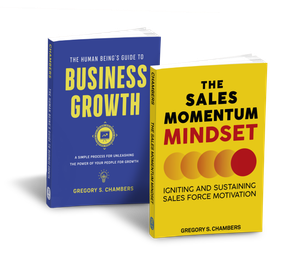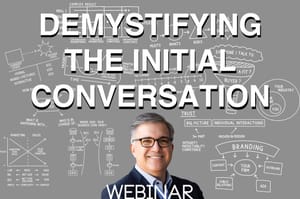Right FIT #162: Golden expectations, Valuing value, Arguing

GREG'S RIGHT FIT NEWSLETTER #161
Quick notes to help you get more sales and marketing done in less time. . . next week.
In this issue:
- Techniques for FIT
- Being Human
- Random Stuff
Techniques for FIT
- Remember: you're the star of your own movie. There are millions of these "own movies" going on all around you. Life gets easier knowing, "Cada cabeza es un mundo." Each mind is a world unto itself.
- Expectations of the age dictate impatience. WW1 letters to the front lines took under a week, so after 7 days of no letter, dread crept in. Saying, "it's war, expect delays" didn't help. Managing expectations requires us to take our day and age into account. "In four days I get a parcel from France, but you can't reply to my voicemail?"
- Establish where the person you're communicating with is at and meet them there. You'll know you're in the right place when you describe where they are and get a "Yes, that's true," response. A world apart from, "Yes, you're correct."
- The golden rule suggests that we consider how we'd feel and act accordingly. Next week, I'm suggesting you take it a step further and consider how your prospects/clients/ employees feel and act accordingly. Level up, as the kids might say.
Being Human - Listening for value ------------------------------------------------------------
"Value. . .is the worth in monetary terms of the technical, economic, service, and social benefits a customer receives in exchange for the price it pays for a market offering." - Professors J. Anderson & J. Narus in the HBR

Listening for Value
The quote above comes from an old HBR article titled "Business Marketing: Understand What Customers Value" and the authors suggest that sellers can sell more if they go deep on the data to explain value to customers. Aiming less for, “Trust us—our mulch film will lower your costs. We’ll provide superior value for your money.” and more for "We can lower the cost of your mulch film by $16.83 per acre, let me show you exactly how."
I agree with the concept but it's missing one key component. Value rests within the customer, not inside the product. One committee may indeed understand and prioritize saving $16.83 an acre, but yet another committee may feel like savings are meaningless if they don't have staff to apply the mulch film, so they look for a solution that prioritizes finding labor.
To get to this level of understanding with your customers and know what they value, you have to ask questions. The rest of this note makes a couple of assumptions. One is that you are able to get in front of people, which isn't such an easy task. And two, you need to be talking to buyers which adds another level of complexity. Here's what I've learned and the research bears it out, the better you are at asking the questions that uncover value, the more likely you are to get in front of true buyers. Now, with that said, let's identify some value buckets you are listening to fill.
As the authors of that HBR article state, moving from high level abstractions to specifics helps buyers make a decision. Your job is to ask questions and listen for value to monetize with the customer. That way, if dollars per acre savings is less important than labor challenges, you can monetize and build value in labor savings. The key is to focus on what the customer cares about, not what you come up with sitting in your corner office.
Here are some buckets your people can listen for, learn how to measure, and then put a monetary value on with customers.
- Decisions - Bad decisions, Slow decisions, No decisions.
- Lost opportunities
- Keeping investments/dollars spent safe
- Highly compensated executive's time
- Market share
- Increased profitability over time
- Increased value in the eyes of investors
- Unproductive time
- Having options available
When you hear any of these seemingly soft, hard to measure outcomes, you can begin to monetize their value to the customer. How? The big four value questions:
- How do you measure that?
- What is it now?
- What do you want it to be?
- What's the value of the difference, over time?
Every company has things they measure. Every company has things they value and prioritize. Will your people hear them when they're offered? Will your people offer them when they're not?
If you need more on this subject, let's talk. It's what I do.
Good stuff.
Random Stuff
Let's argue

Before I get too far, I want you to know I wrote an article for Insightful Accountant, "It's Not You, It's Me – Surviving Client Transitions," with insights on learning how to build empathy with inherited accounts. It's good stuff.
I've spent the week stewing. Not about my team's inability to execute an inbounds play in the last minute of regulation. Not about the temperatures which refuse to get above 32F. No, I'm frustrated with my tendency to get into lighthearted debates with lawyers and politicians.
I've been reading studies saying human interaction is the key to happiness, but I'm guessing I missed a footnote about arguing with professional arguers. It isn't the content of the argument that gets to me. It isn't the inability to fact check on the fly or even the challenge of staying on topic after a few barley pops. No, what gets to me is the flood of arguments that pop into my head for the following week.
You see, I'm not an instant argument guy. I need to ponder, to walk a bit, and examine what I think. Standing in a butler's pantry, talking about the value of economic incentives while tipping a few drinks isn't where I shine. I've noticed this since Cunningham and I debated some over-prepared forensics students our freshman year in high school. They talked fast, used lots of facts, and overwhelmed us with evidence. We looked at each other, stood up, shrugged our shoulders and said, "Good luck! We like your plan," then got chewed out by the debate coach. Hey, it's just not my bag, baby. I need to recognize that in real time.
I'll leave you with this warning. Next week, if we're talking and I try to bring up Amazon's headquarters, be careful. There's a good chance that this time I have an example ready.
Booking Calendar
If you need to set up a time to visit, follow this link:
https://calendly.com/chamberspivot/





